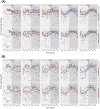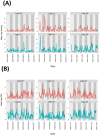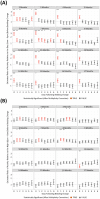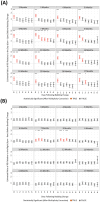Automated home cage monitoring of an aging colony of mice-Implications for welfare monitoring and experimentation
- PMID: 39534023
- PMCID: PMC11554610
- DOI: 10.3389/fnins.2024.1489308
Automated home cage monitoring of an aging colony of mice-Implications for welfare monitoring and experimentation
Abstract
Introduction: Our understanding of laboratory animal behavior and the implications of husbandry activities on their wellbeing remains incomplete. This is especially relevant with an aging colony as their activity patterns may change as they mature. Home Cage Monitoring (HCM) provides valuable insights into mouse activity within the animal's own environment and can shed light on acclimatization periods and responses to husbandry activities such as cage changing. The aim of this study was to monitor and explore changes in the activity and rest disturbance (RDI) patterns of an aging colony of male and female C57/BL6 mice.
Methods: The mice were housed in the Digitally Ventilated Cage® system, for up to 18 months of age. Data was then downloaded to investigate how the activity patterns and RDI of the mice changed over time. Habituation, aging and cage change assessments were conducted using linear mixed models, while cage separation and stereotypic behavior investigations were conducted by visual inspection of the data.
Results: As expected during the study, mice were less active during the light phase compared to the dark phase. However, on arrival mice displayed heightened activity and RDI during the light phase and reduced activity and RDI during the dark phase, taking several days to adjust to baseline "acclimatized" patterns. With age, overall activity significantly decreased from 5 months until 14 months of age, after which it increased back toward baseline levels. We also observed activity spikes during our monitoring of this colony. Prolonged housing can lead to alarming stereotypic behaviors in animals. Cages of mice flagged for potential stereotypy displayed sustained activity spikes in the light and dark phases. Spikes in activity during the dark phase were much more pronounced than in the light phase. Cage changing led to an increase in the light phase activity and RDI compared to the previous day, with no observed difference in the dark phase post-cage change. This effect remained consistent as the animals aged.
Discussion: This study explores changes in the activity patterns of an aging colony of male and female C57/BL6 mice housed in the Digitally Ventilated Cage® system. We identified distinct aging phases concerning activity and RDI differences and a potential new welfare application for the DVC®, specifically for early detection of stereotypy. In conclusion, the adoption of HCM systems should be considered for long-term animal housing from both a welfare and behavioral perspective.
Keywords: acclimatization period; activity-biomarkers; aging; animal welfare; cage changing; circadian rhythm; home cage monitoring; rodent behavior.
Copyright © 2024 Moore, Kennedy and Hassan.
Conflict of interest statement
JK and A-AH were employed by company GlaxoSmithKline. The remaining author declares that the research was conducted in the absence of any commercial or financial relationships that could be construed as a potential conflict of interest.
Figures








Similar articles
-
Towards large scale automated cage monitoring - Diurnal rhythm and impact of interventions on in-cage activity of C57BL/6J mice recorded 24/7 with a non-disrupting capacitive-based technique.PLoS One. 2019 Feb 4;14(2):e0211063. doi: 10.1371/journal.pone.0211063. eCollection 2019. PLoS One. 2019. PMID: 30716111 Free PMC article.
-
A systematic review of the development and application of home cage monitoring in laboratory mice and rats.BMC Biol. 2023 Nov 13;21(1):256. doi: 10.1186/s12915-023-01751-7. BMC Biol. 2023. PMID: 37953247 Free PMC article.
-
Detection of aberrant locomotor activity in a mouse model of lung cancer via home cage monitoring.Front Oncol. 2024 Dec 23;14:1504938. doi: 10.3389/fonc.2024.1504938. eCollection 2024. Front Oncol. 2024. PMID: 39763604 Free PMC article.
-
Effect of Environmental Enrichment on Aggression in BALB/cJ and BALB/cByJ Mice Monitored by Using an Automated System.J Am Assoc Lab Anim Sci. 2018 May 1;57(3):236-243. doi: 10.30802/AALAS-JAALAS-17-000122. Epub 2018 Apr 18. J Am Assoc Lab Anim Sci. 2018. PMID: 29669621 Free PMC article.
-
IntelliCage: the development and perspectives of a mouse- and user-friendly automated behavioral test system.Front Behav Neurosci. 2024 Jan 3;17:1270538. doi: 10.3389/fnbeh.2023.1270538. eCollection 2023. Front Behav Neurosci. 2024. PMID: 38235003 Free PMC article. Review.
References
-
- Ai M., Hotham W. E., Pattison L. A., Ma Q., Henson F. M. D., Smith E. S. J. (2023). Role of human mesenchymal stem cells and derived extracellular vesicles in reducing sensory neuron hyperexcitability and pain behaviors in murine osteoarthritis. Arthrit. Rheumatol. 75, 352–363. 10.1002/art.42353 - DOI - PMC - PubMed
-
- Bains R. S., Forrest H., Sillito R. R., Armstrong J. D., Stewart M., Nolan P. M., et al. . (2023). Longitudinal home-cage automated assessment of climbing behavior shows sexual dimorphism and aging-related decrease in C57BL/6J healthy mice and allows early detection of motor impairment in the N171-82Q mouse model of Huntington's disease. Front. Behav. Neurosci. 17:1148172. 10.3389/fnbeh.2023.1148172 - DOI - PMC - PubMed
-
- Baumans V. (2007). “The welfare of laboratory mice,” in The Welfare of Laboratory Animals (Dordrecht: Springer Netherlands; ), 119–152.
LinkOut - more resources
Full Text Sources
Research Materials

